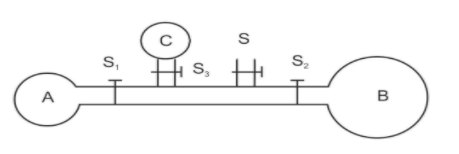
The adjoining diagram shows three soap bubbles$A,B$ and $C$ prepared by blowing the capillary tube fitted with stop cocks $S,{S_1},{S_2}$ and ${S_3}$ with stop cock $S$ closed and stop cocks $S,{\text{ }}{S_1}{\text{ }}and{\text{ }}{S_2}$opened :-

A) ${\text{B will start collapsing with volumes of A and C increasing }}$
B) ${\text{C will start collapsing with volumes of A and B increasing }}$
C) ${\text{C and A will both start collapsing with volumes of B increasing }}$
D) ${\text{Volumes of A,B,C will becomes equal at equilibrium}}$
Answer
218.7k+ views
Hint: To answer such a question, one has to be very much aware of the relation between the pressure and radius of the bubble. We know that the pressure under the soap bubble is always greater than the pressure that exists outside the soap bubble.
Complete step by step answer:
According to the question, we have been given three soap bubbles whose all the valves are being open then how the pressure inside the bubble changes.
From the figure given above we can conclude that the relation between the radius of $ \Rightarrow {r_C} < {r_A} < {r_B}$.
As we know that the pressure inside the soap bubble is always greater as compared to the pressure outside the bubble and the relation between the two is given as $\Delta P$.
The relation between the pressure and the radius is given as follows:
$ \Rightarrow \Delta P = \dfrac{{4s}}{r}$
Where, the symbols have their usual meaning as the $s$ stands for surface tension and the $r$ stands for radius of the bubble.
From the above equation one can find out that the pressure is inversely proportional to that of the radius of the bubble.
Therefore, the largest pressure is inside the $C$ as the pressure is lower as the radius is largest. Similarly, the radius of the bubble $A$ is also smaller as compared to that of the $B$ . Therefore, one can understand that the molecules from both the bubbles of smaller radius will move on the bubble of the larger radius and therefore that bubble will expand, and rest will collapse.
Looking at the options one can easily make out that the volume of both $A{\text{ }}and{\text{ }}C$ will collapse and volume of $B$ should increase.
Therefore, the correct option is option (C).
Note: The knowledge of pressure and volume should be clear to the person while handling such kinds of questions. One should also take care of the pressure inside and outside the system which is being considered. Also here we have assumed the surface tension of all bubbles to be equal
Complete step by step answer:
According to the question, we have been given three soap bubbles whose all the valves are being open then how the pressure inside the bubble changes.
From the figure given above we can conclude that the relation between the radius of $ \Rightarrow {r_C} < {r_A} < {r_B}$.
As we know that the pressure inside the soap bubble is always greater as compared to the pressure outside the bubble and the relation between the two is given as $\Delta P$.
The relation between the pressure and the radius is given as follows:
$ \Rightarrow \Delta P = \dfrac{{4s}}{r}$
Where, the symbols have their usual meaning as the $s$ stands for surface tension and the $r$ stands for radius of the bubble.
From the above equation one can find out that the pressure is inversely proportional to that of the radius of the bubble.
Therefore, the largest pressure is inside the $C$ as the pressure is lower as the radius is largest. Similarly, the radius of the bubble $A$ is also smaller as compared to that of the $B$ . Therefore, one can understand that the molecules from both the bubbles of smaller radius will move on the bubble of the larger radius and therefore that bubble will expand, and rest will collapse.
Looking at the options one can easily make out that the volume of both $A{\text{ }}and{\text{ }}C$ will collapse and volume of $B$ should increase.
Therefore, the correct option is option (C).
Note: The knowledge of pressure and volume should be clear to the person while handling such kinds of questions. One should also take care of the pressure inside and outside the system which is being considered. Also here we have assumed the surface tension of all bubbles to be equal
Recently Updated Pages
Two discs which are rotating about their respective class 11 physics JEE_Main

A ladder rests against a frictionless vertical wall class 11 physics JEE_Main

Two simple pendulums of lengths 1 m and 16 m respectively class 11 physics JEE_Main

The slopes of isothermal and adiabatic curves are related class 11 physics JEE_Main

A trolly falling freely on an inclined plane as shown class 11 physics JEE_Main

The masses M1 and M2M2 M1 are released from rest Using class 11 physics JEE_Main

Trending doubts
Understanding Collisions: Types and Examples for Students

Understanding Atomic Structure for Beginners

Understanding Centrifugal Force in Physics

JEE Main Marking Scheme 2026- Paper-Wise Marks Distribution and Negative Marking Details

Understanding Electromagnetic Waves and Their Importance

Ideal and Non-Ideal Solutions Explained for Class 12 Chemistry

Other Pages
Understanding Average and RMS Value in Electrical Circuits

NCERT Solutions For Class 11 Physics Chapter 4 Laws Of Motion

Understanding Excess Pressure Inside a Liquid Drop

NCERT Solutions For Class 11 Physics Chapter 12 Kinetic Theory - 2025-26

NCERT Solutions For Class 11 Physics Chapter 13 Oscillations - 2025-26

Motion In A Plane Class 11 Physics Chapter 3 CBSE Notes - 2025-26




